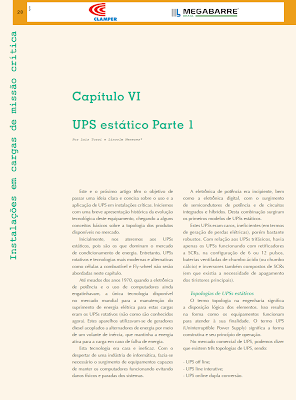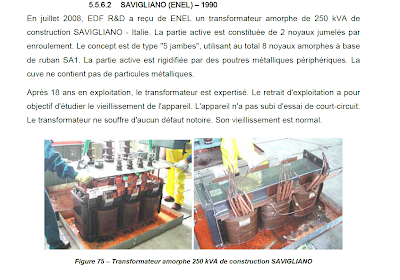sexta-feira, 13 de setembro de 2013
quinta-feira, 12 de setembro de 2013
terça-feira, 10 de setembro de 2013
An Overview on Amorphous Core Transformers Man Mohan Electrical Engineering Department

Abstract
In this paper, an amorphous core transformer is highlighted. Configuration of amorphous C-core and its magnetisation characteristic (B-H) are described. Factors affecting the design are also discussed as a comparison with a conventional transformer. It is concluded that, advantages with amorphous core transformers are - low core losses, low magnetising current, less zero sequence current, less noise, higher efficiency and longer life; however the disadvantages are higher inrush current, more harmonic problem, bigger size and higher initial cost. The problem of third harmonic may be eliminated by adopting zig-zag connection in place of star connection. Purpose of this article is to provide a knowledge base about amorphous core transformers, to students of transformer design, by discussing some necessary issues. __________________________________________________________________________________________ LINK
http://www.mediafire.com/?1kicbyeispkdgqe
Amorphous-Core Transformer with Copper Winding Versus Aluminium Winding-A Comparative Study
Amorphous core transformers are in developing stage; they are considered as energy efficient transformers. Cost of amorphous core transformer is about 20 to 30 per cent higher than that of a conventional transformer of same KVA rating. Among several parameters, cost of winding material is a parameter, on which cost of a transformer depends. In a transformer, the cost of winding material may be up to 28 per cent of overall cost of a transformer. Cost of a transformer may be reduced if aluminum winding is adopted in place of copper winding; aluminum is lighter in weight and cheaper in price, compared to copper winding. Here, a comparative study is presented for an amorphous core transformer with copper winding versus aluminum winding, in terms of cost efficiency and mechanical forces. It has been found that, if aluminum winding is adopted for 400KVA amorphous core transformer, the cost reduces, efficiency improves and mechanical forces.
DOWNLOAD FULL PAPER
http://www.ejournalofscience.org/archive/vol2no4/vol2no4_4.pdf
domingo, 8 de setembro de 2013
UNIVERSIDADE FEDERAL DO RIO GRANDE DO SUL ESCOLA DE ENGENHARIA DEPARTAMENTO DE ENGENHARIA ELÉTRICA MÁRCIO MOURA DE MATTOS PROJETO DE DIPLOMAÇÃO ESTUDO DO FATOR K EM TRANSFORMADORES A SECO BRASIL
RESUMO
Este trabalho tem por finalidade apresentar um
estudo sobre harmônicas suas causas e
suas conseqüências em instalações elétricas.
Será realizado um estudo da decomposição dos
sinais de energia elétrica através da decomposição da Séria de Fourier,
a partir da qual serão mostrada e calculada as diferente ordens das harmônicas
Será dada ênfase nas conseqüências
dessas em transformadores a seco.
Onde será calculado o Fator K em seus dois modos o
modo da UL e o modo que é assumido por muito autores como sendo o Fator K normalizado.
.
Esse estudo está diretamente
relacionado com a temperatura de funcionamento do
transformador e sua vida útil.
Para exemplificar o estudo será
mostrada a constituição do
transformador a seco fabricado
pela empresa SIEMENS, que recebe o nome de GEAFOL.
ARTICULO COMPLETO
http://www.lume.ufrgs.br/bitstream/handle/10183/65619/000864745.pdf?sequence=1
ARTICULO COMPLETO
http://www.lume.ufrgs.br/bitstream/handle/10183/65619/000864745.pdf?sequence=1
“Cálculo das Perdas Técnicas dos Transformadores de Distribuição, Operando em Ambiente Não-Senoidal” Luciano Dos Santos UNESP UNIVERSIDADE ESTADUAL PAULISTA CAMPUS DE ILHA SOLTEIRA PROGRAMA DE PÓS-GRADUAÇÃO EM ENGENHARIA ELÉTRICA BRASIL
Dissertação submetida à Faculdade de
Engenharia de Ilha Solteira – UNESP - como
parte dos requisitos exigidos para a obtenção
do título de
Mestre em Engenharia Elétrica.
RESUMO
Este trabalho está direcionado à implementação de uma modelagem que venha possibilitar a
realização dos cálculos das perdas técnicas no cobre do transformador trifásico de distribuição
operando em condições não-senoidais, através da utilização do valor médio de Distorção
Harmônica Total de Corrente drenada por suas cargas. Essa implementação visa facilitar a
obtenção dos valores das perdas técnicas para múltiplas unidades transformadoras. Para atingir o
objetivo mencionado, realizou-se um ensaio em curto-circuito através de ensaios experimentais
aplicadas em uma unidade transformadora trifásica de distribuição com 15 kVA de capacidade. A
fonte trifásica de alimentação utilizada na atividade proporciona o ajuste de tensão e da
freqüência, possibilitando obter os valores de resistências CA dos enrolamentos do transformador
para diferentes ordens harmônicas. Com o propósito de validar esta nova proposta, foi realizada
uma análise confrontando-se os dados obtidos através da modelagem proposta neste trabalho e de
uma outra bastante difundida pela literatura atual. Os cálculos foram efetuados utilizando-se
dados de distorções harmônicas de correntes oriundas de medições de ramais de distribuição.
Através da comparação dos resultados obtidos é possível verificar a validade da modelagem proposta.
TESIS COMPLETA
http://www.feis.unesp.br/Home/departamentos/engenhariaeletrica/pos-graduacao/167-dissertacao_luciano_dos_santos.pdf
RESUMO
Este trabalho está direcionado à implementação de uma modelagem que venha possibilitar a
realização dos cálculos das perdas técnicas no cobre do transformador trifásico de distribuição
operando em condições não-senoidais, através da utilização do valor médio de Distorção
Harmônica Total de Corrente drenada por suas cargas. Essa implementação visa facilitar a
obtenção dos valores das perdas técnicas para múltiplas unidades transformadoras. Para atingir o
objetivo mencionado, realizou-se um ensaio em curto-circuito através de ensaios experimentais
aplicadas em uma unidade transformadora trifásica de distribuição com 15 kVA de capacidade. A
fonte trifásica de alimentação utilizada na atividade proporciona o ajuste de tensão e da
freqüência, possibilitando obter os valores de resistências CA dos enrolamentos do transformador
para diferentes ordens harmônicas. Com o propósito de validar esta nova proposta, foi realizada
uma análise confrontando-se os dados obtidos através da modelagem proposta neste trabalho e de
uma outra bastante difundida pela literatura atual. Os cálculos foram efetuados utilizando-se
dados de distorções harmônicas de correntes oriundas de medições de ramais de distribuição.
Através da comparação dos resultados obtidos é possível verificar a validade da modelagem proposta.
TESIS COMPLETA
http://www.feis.unesp.br/Home/departamentos/engenhariaeletrica/pos-graduacao/167-dissertacao_luciano_dos_santos.pdf
domingo, 1 de setembro de 2013
REDUCTION DES PERTES A VIDE DES TRANSFORMATEURS DE DISTRIBUTION PAR UTILISATION DE RUBANS AMORPHES by Malick MOUHAMAD
THESE DE DOCTORAT
DE L’ECOLE NORMALE SUPERIEURE DE CACHAN
Présentée par
Malick MOUHAMAD
pour obtenir le grade de
DOCTEUR DE L’ECOLE NORMALE SUPERIEURE DE CACHAN
Domaine :
ELECTRONIQUE – ELECTROTECHNIQUE – AUTOMATIQUE
REDUCTION DES PERTES A VIDE DES TRANSFORMATEURS DE DISTRIBUTION PAR UTILISATION DE RUBANS AMORPHES
Thèse présentée et soutenue à Cachan le 28/02/2012
Abstract
This PhD dissertation deals with the application of amorphous ribbons in distribution transformer cores in order to reduce network losses.
The material is an alloy from iron, boron and silicon compounds. The first results on the material reveal a good physicochemical compatibility with tested transformer dielectric fluids. It should be noted these materials possess a far longer life than the transformer itself.
The potential for reducing losses from distribution transformers is considered as one element of EU and national strategies on energy efficiency. Losses generated through amorphous transformers are twice less than conventional ones.
Amorphous ribbon units represent a significant new advance in transformer technology and losses reduction. The investment, put to purchase the product, can be easily gained by the capitalisation of losses. The return can be achieved in 10 to 12 years, depending on the purchase price.
It is expected that a transformer will be subjected to a number of short-circuits during its service life, but sooner or later one such event will cause some slight winding movement, and the ability of the transformer to resist further short-circuits will then be severely reduced.
Amorphous metal distribution transformers (AMDT) is no exception and they should be able to resist electrodynamic forces during short-circuit test and match ERDF specifications. In fact, during SC, extreme electrodynamic forces cause the windings to deform and this shape deformity creates a lot of shear stress on amorphous cores which lead to break-up of some ribbons. The active part of an amorphous transformer should be strong enough to resist these stresses.
In fact, the behaviour of the core materials under short circuit currents depends especially on the know-how of manufacturers who can outline electrodynamic stress inside transformers. Concept design and processes have been improved in order to provide reliable devices but the task is not completely done yet.
Short-circuit withstand is one of the most important aspects which will approve this technology.
DOWNLOAD FULL THESIS
http://innovation.edf.com/fichiers/fckeditor/Commun/Innovation/theses/TheseMouhamad.pdf
DE L’ECOLE NORMALE SUPERIEURE DE CACHAN
Présentée par
Malick MOUHAMAD
pour obtenir le grade de
DOCTEUR DE L’ECOLE NORMALE SUPERIEURE DE CACHAN
Domaine :
ELECTRONIQUE – ELECTROTECHNIQUE – AUTOMATIQUE
REDUCTION DES PERTES A VIDE DES TRANSFORMATEURS DE DISTRIBUTION PAR UTILISATION DE RUBANS AMORPHES
Thèse présentée et soutenue à Cachan le 28/02/2012
Abstract
This PhD dissertation deals with the application of amorphous ribbons in distribution transformer cores in order to reduce network losses.
The material is an alloy from iron, boron and silicon compounds. The first results on the material reveal a good physicochemical compatibility with tested transformer dielectric fluids. It should be noted these materials possess a far longer life than the transformer itself.
The potential for reducing losses from distribution transformers is considered as one element of EU and national strategies on energy efficiency. Losses generated through amorphous transformers are twice less than conventional ones.
Amorphous ribbon units represent a significant new advance in transformer technology and losses reduction. The investment, put to purchase the product, can be easily gained by the capitalisation of losses. The return can be achieved in 10 to 12 years, depending on the purchase price.
It is expected that a transformer will be subjected to a number of short-circuits during its service life, but sooner or later one such event will cause some slight winding movement, and the ability of the transformer to resist further short-circuits will then be severely reduced.
Amorphous metal distribution transformers (AMDT) is no exception and they should be able to resist electrodynamic forces during short-circuit test and match ERDF specifications. In fact, during SC, extreme electrodynamic forces cause the windings to deform and this shape deformity creates a lot of shear stress on amorphous cores which lead to break-up of some ribbons. The active part of an amorphous transformer should be strong enough to resist these stresses.
In fact, the behaviour of the core materials under short circuit currents depends especially on the know-how of manufacturers who can outline electrodynamic stress inside transformers. Concept design and processes have been improved in order to provide reliable devices but the task is not completely done yet.
Short-circuit withstand is one of the most important aspects which will approve this technology.
DOWNLOAD FULL THESIS
http://innovation.edf.com/fichiers/fckeditor/Commun/Innovation/theses/TheseMouhamad.pdf
Assinar:
Postagens (Atom)
















































 JOSIL ARTISTA PLASTICO FORTALEZA CEARA BRASIL AV.HERACLITO GRAÇA 41 TEL(85)32542378
JOSIL ARTISTA PLASTICO FORTALEZA CEARA BRASIL AV.HERACLITO GRAÇA 41 TEL(85)32542378















